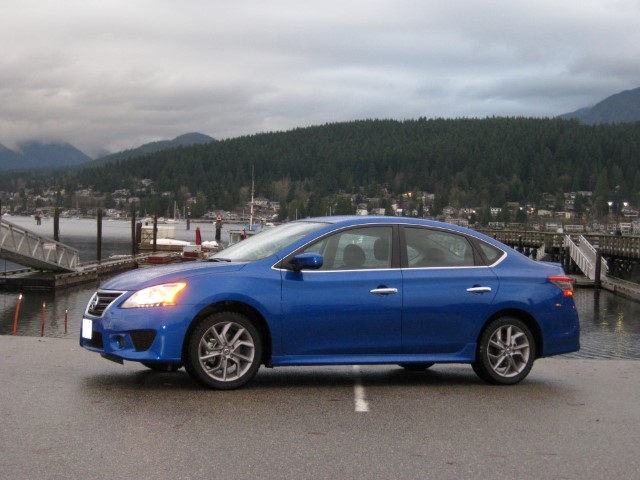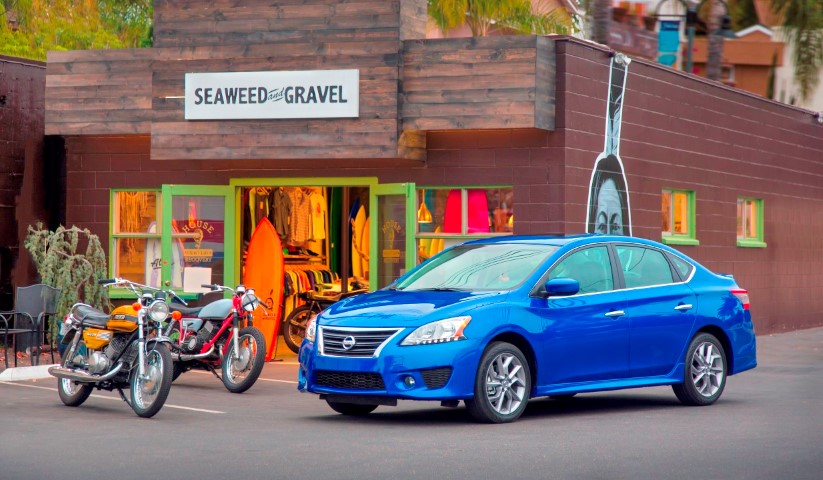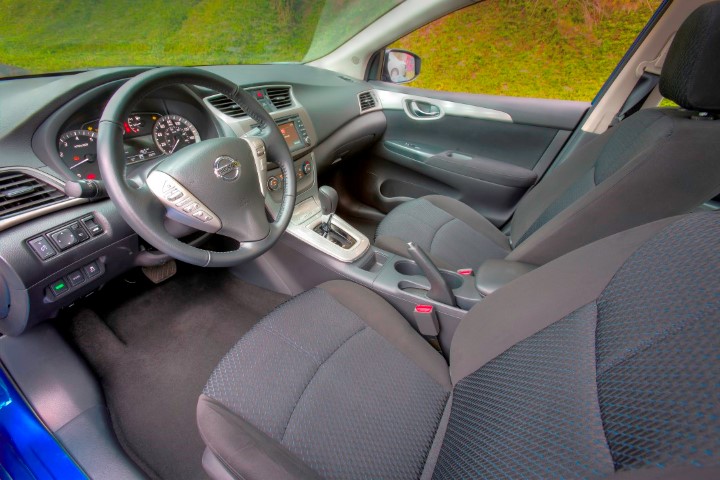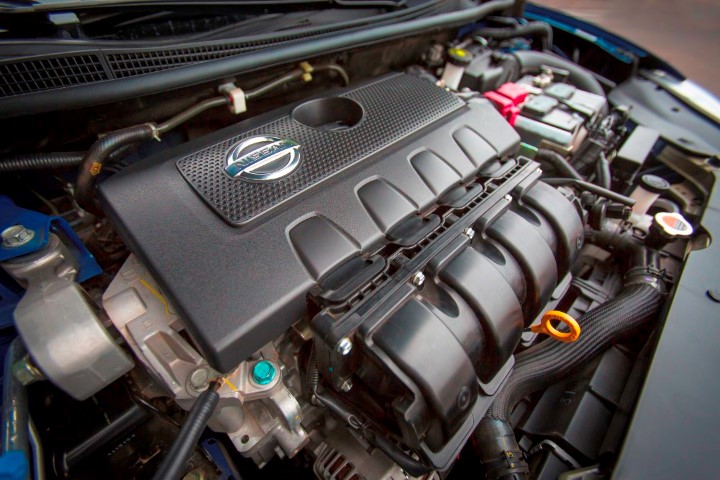2013 Nissan Sentra Review: no longer the unappealing sibling
- Written by David Miller
- Published in CAR REVIEWS
- font size decrease font size increase font size
- Be the first to comment!

Vancouver, BC – When you think about the Nissan Sentra – the words affordable and reliable come to mind. The Sentra is definitely not an emotional purchase, but Nissan feels this seventh-generation version will change people’s perceptions and expand its appeal to younger business professionals.
The Sentra can no longer be labelled boring with its upgrade in style, sophistication and refinement which resembles more of its elder siblings, the Altima and Maxima. This is a big move for a car that seems to have been built in the past for someone who’s not a driving enthusiast, but in the highly competitive compact sedan segment – it’s essential.
What struck me the most was the redesigned exterior that gave the Sentra a sleek modern look. Its lower roofline and large wrap-around headlights and taillights with LED accents were the main changes that transformed its look and worked well with Nissan’s standard chrome trapezoid-shaped front grille. The Sentra’s new exterior seems focused in attracting a broader and younger audience which it desperately needs in a crowded compact segment that accounts for 23 percent of all automotive sales.
 Nissan was very excited to show off their Sentra and they chose the beautiful city of Vancouver to do so. They provided us with SR and SL models to try out – which would be the top two of four in their model lineup. The base S model starts at $14,898 and goes up to $22,998 in the SL. The model that Nissan expects the most sales to come in is the second tier SV, which starts at $17,548 and has unexpected premium features such as a start/stop push button, Sirius satellite radio, leather steering wheel, and a six-speaker audio system.
Nissan was very excited to show off their Sentra and they chose the beautiful city of Vancouver to do so. They provided us with SR and SL models to try out – which would be the top two of four in their model lineup. The base S model starts at $14,898 and goes up to $22,998 in the SL. The model that Nissan expects the most sales to come in is the second tier SV, which starts at $17,548 and has unexpected premium features such as a start/stop push button, Sirius satellite radio, leather steering wheel, and a six-speaker audio system.
I chose the SR model that only comes in Nissan’s second-generation Xtronic continuously variable transmission (CVT) – the same that’s found in the Nissan Versa Sedan. You can only choose a six-speed manual transmission in the base S and SV models, as historical numbers showed there wasn’t a big manual sales expectation. The SR has a sportier and youthful appeal with restyled “sport” front and rear fascias, 17” alloy wheels coupled with a rear spoiler and chrome exhaust.
 As I sat down in the new Sentra – you can see the improvements from the outgoing model, but the interior doesn’t excite you as much as the changes outside. The SR features bolstered seats with premium sport cloth which is nice and comfy – perhaps better than the upscale leather choice in the SL. Maybe the drawbacks can be found in trying to envision a premium compact vehicle as the interior just resembles a simple but nice layout. The controls are very straightforward and easy to understand and adjust. It’s fitted with a nice soft-touch leather dash and has an ample amount of legroom and headroom even more than its Toyota Corolla, Honda Civic and Mazda3 rivals. It’s no different in the back row as it contains the most legroom of any of its primary competitors.
As I sat down in the new Sentra – you can see the improvements from the outgoing model, but the interior doesn’t excite you as much as the changes outside. The SR features bolstered seats with premium sport cloth which is nice and comfy – perhaps better than the upscale leather choice in the SL. Maybe the drawbacks can be found in trying to envision a premium compact vehicle as the interior just resembles a simple but nice layout. The controls are very straightforward and easy to understand and adjust. It’s fitted with a nice soft-touch leather dash and has an ample amount of legroom and headroom even more than its Toyota Corolla, Honda Civic and Mazda3 rivals. It’s no different in the back row as it contains the most legroom of any of its primary competitors.
Powering the Sentra is an all-new 1.8-liter four-cylinder engine with a DOHC design that cranks out 130 hp and 128 lb.-ft. of torque. As mentioned previously, most of the Sentra’s are fitted with their latest Xtronic CVT and I’m sure many of you are wondering how it performed?
 Well I can tell you it’s better than before, but still not ideal. You will never please a driver enthusiast about not having a driving feel and that lack of power sense with a CVT – but as I mentioned before the Sentra is not for that type of driver. It was slow to respond to quick throttle input and still had that irritating wheezing noise as it accelerated, but the drawbacks that it has will help you save at the end of the day with the class-leading combined fuel economy scores the CVT helped the Sentra achieve. The Sentra bests their rivals with a combined city/highway fuel economy number of 5.8L/ 100 km just ahead of the Hyundai Elantra and Chevy Cruze. When you break it down, the Sentra achieves 6.6 L/ 100km in the city and 4.9L/ 100km on the highway.
Well I can tell you it’s better than before, but still not ideal. You will never please a driver enthusiast about not having a driving feel and that lack of power sense with a CVT – but as I mentioned before the Sentra is not for that type of driver. It was slow to respond to quick throttle input and still had that irritating wheezing noise as it accelerated, but the drawbacks that it has will help you save at the end of the day with the class-leading combined fuel economy scores the CVT helped the Sentra achieve. The Sentra bests their rivals with a combined city/highway fuel economy number of 5.8L/ 100 km just ahead of the Hyundai Elantra and Chevy Cruze. When you break it down, the Sentra achieves 6.6 L/ 100km in the city and 4.9L/ 100km on the highway.
The drive itself around the downtown area of Vancouver was very smooth thanks to the new CVT. It’s well suited for the standard commute and accelerates with ease and at a relaxing cruising speed – it’s in its glory. The handling was adequate around corners and held its own, but the steering feel was lacking compared to the Elantra and the Mazda3. The Sentra comes in three drive modes that affect throttle response and transmission changes – Normal, Sport and Eco. For most of the time I was in the Sport mode, but later adjusted to Eco to see the difference. Sport mode didn’t help much in terms of a quicker throttle response, but in Eco mode we were definitely cruising at lower rpm’s.
 After some time with the Sentra – I think Nissan has made great strides in addressing its looks and has elevated the Sentra’s looks to be on the same playing field as the Altima and Maxima. It’s an area that needed drastic improvements in adjusting to the 2013 climate of compact sedans and that alone can catapult them into a contender. It's not going to be enough to knock the Honda Civic from their number one sales spot in Canada, but it's a step in the right direction. If you’re looking for a compact sedan mostly used for commutes, weekend drives, and the occasional vacation – the Sentra can suit your needs very well. If you’re someone who needs a bit more of a kick in performance at times – than the Sentra will slightly disappoint.
After some time with the Sentra – I think Nissan has made great strides in addressing its looks and has elevated the Sentra’s looks to be on the same playing field as the Altima and Maxima. It’s an area that needed drastic improvements in adjusting to the 2013 climate of compact sedans and that alone can catapult them into a contender. It's not going to be enough to knock the Honda Civic from their number one sales spot in Canada, but it's a step in the right direction. If you’re looking for a compact sedan mostly used for commutes, weekend drives, and the occasional vacation – the Sentra can suit your needs very well. If you’re someone who needs a bit more of a kick in performance at times – than the Sentra will slightly disappoint.
The Sentra doesn’t convey premium, perhaps, it’s just a lot more premium than its outgoing model, but it’s impressive how many gadgets and luxuries are standard in its second-tier model, the SV – which makes it a lot of value for the money at $17,548 for the manual and $18,848 for the CVT. When you also factor in its size with tons of headroom and legroom throughout and one of the roomiest trunks in its class – the Sentra has done their job in expanding their market and is a sensible choice for young professionals and families.
